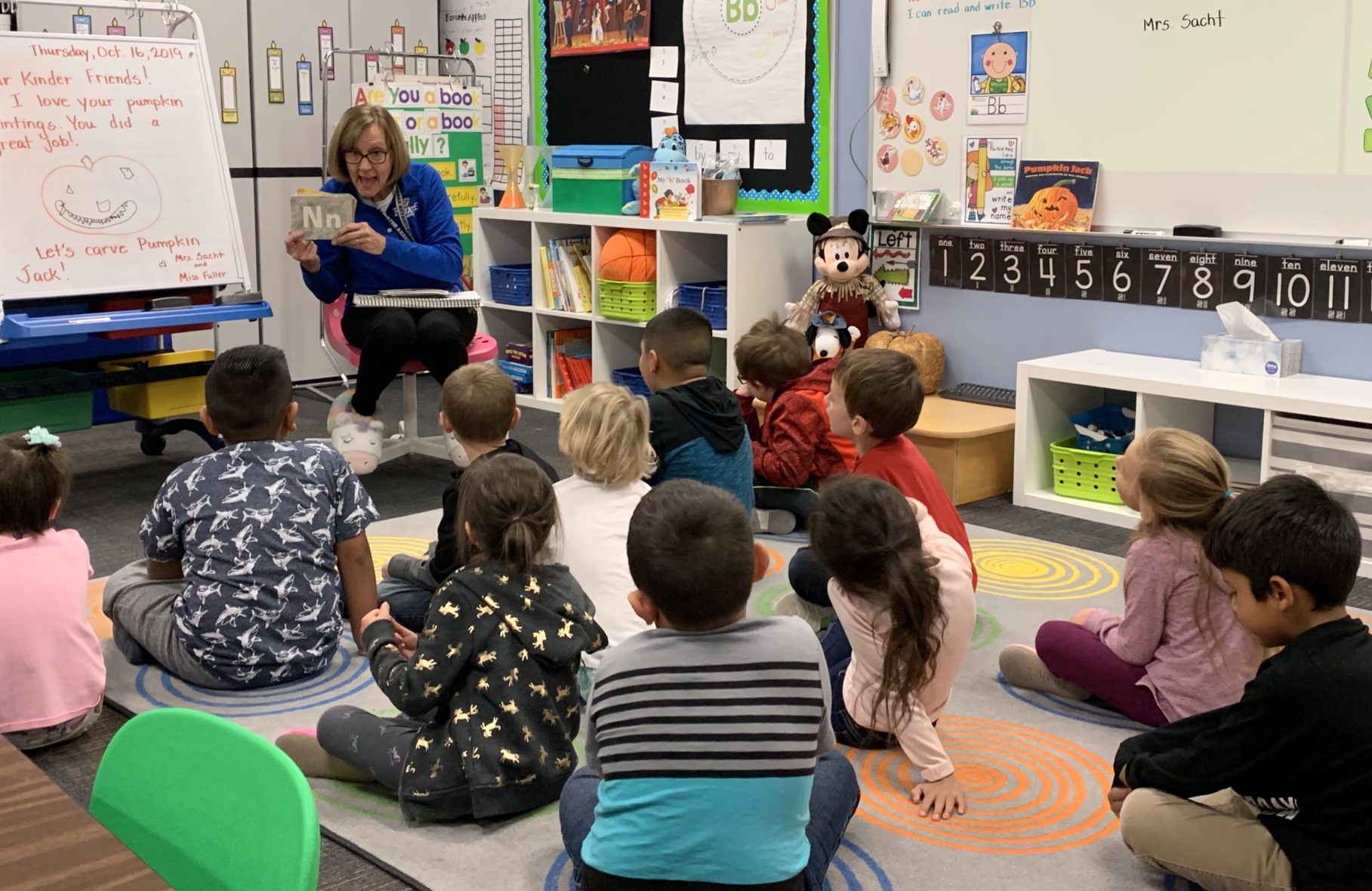
Megan Ferrel’s kindergartner Finnley struggled on his fall reading test, and now he’s getting extra help through all-day kindergarten at Emmett’s Shadow Butte Elementary School.
Ferrel suspected her son needed extra help, so the results didn’t surprise her. But the online test still troubled her. She limits screen time at home — a tablet during a flight or a smartphone game in a waiting room. “We decided that we’re not going to let them have devices any time they want.”
For kindergartners such as Finnley, the fall Idaho Reading Indicator is the first test they take. It’s about a 20-minute screener, but it’s an important one. Teachers use the IRI to gauge the reading skills of close to 90,000 students from kindergarten through third grade.
By and large, teachers say the new IRI provides better data and timelier information than its predecessor. But many teachers concede the online format poses problems. And two years in, teachers and administrators are still learning about the new test — learning from their mistakes, and making course corrections along the way.
New — and improved?
The rebooted IRI launched in 2018-19, after a one-year pilot run in about 50 schools. The idea was to come up with a better test to support Idaho’s multimillion-dollar investment in early literacy.
The old IRI essentially measured only one skill: reading speed, or fluency. The new test provides data on fluency, but also on a variety of other skills. For example, kindergartners are tested on how well they know their letters. First- through third-graders are tested on spelling. In every grade, vocabulary and comprehension are included in the mix.
The new IRI isn’t a one-stop shop. Many schools still use additional tests to gather data, and to prepare students for the time-consuming, Common Core-aligned Idaho Standards Achievement Test that also awaits in third grade. “The IRI all by itself is not going to get us to success on the ISAT,” said Patty Dalrymple, curriculum coordinator for the Bruneau-Grand View School District.
In Cascade Elementary School — a school that posted some of Idaho’s biggest improvements in reading scores in 2018-19 — Crystal Rosen and Michelle Weirum both praise the new IRI.
The old IRI provided “useless information,” said Rosen, Cascade’s kindergarten teacher. The new IRI provides real-time data on two key skills: phonics and phonemic awareness. Phonics and phonemic awareness aren’t identical — the former links spoken sounds with letters, the latter draws the connection between spoken sounds and components of words. But both are building blocks to reading.
Weirum, Cascade’s second-grade teacher, says the old fluency test told only part of the story. “I could have kids who were not fluent or fast readers, but they could comprehend anything.”
But are the numbers valid?
The new IRI provides an abundance of data. Parents can see their kids’ strengths and weaknesses, in detail. Educators can emphasize spelling or vocabulary, for example, if they see troubling school-wide trends.
But a quantity of data does not ensure quality data.

The new IRI represents a tradeoff. In order to get more information, more quickly, teachers have to buy off on an online test.
Even during the pilot phase two years ago, some teachers sounded alarms about the new platform. They said an online IRI tested computing skills instead of reading skills, leaving some students confused and discouraged.
For kindergartners, the challenge can be especially acute. That isn’t just an issue in poorer or rural schools, where families might not own a computer or have access to the Internet. It’s also an issue at Future Public School, a new charter school sitting near the Boise River Greenbelt in Garden City. Despite Future’s emphasis on science and technology, many of its middle- to upper-middle class parents do not want their young children on devices. “There’s a clear faction of folks that are in the self-selection,” co-founder Amanda Cox said.
The IRI also is designed to be more difficult later in the school year, to measure growth. If students don’t get enough practice on a tablet during the year, their scores might drop simply because their computing skills have stagnated, said Stacey Roth, the Boise School District’s administrator of student programs.
For the Boise district — where 2018-19 IRI scores lagged below state averages — the first year of the new test proved to be an eye-opener. Teachers are learning that there are ways to help students out — by testing in smaller groups, so teachers can make sure students don’t zone out, or by breaking up the test into smaller, quicker segments.
“There is some stuff we need to do,” Roth said.
Testing — and retesting
One thing Boise plans to do this year is to administer the IRI more frequently.
Schools must administer the test in the fall and the spring. Last year, Boise students took the test in the fall, winter and spring. That probably wasn’t enough, and it probably didn’t provide teachers with the necessary data, said R.T. Duke, the district’s English language arts supervisor. Boise is working in additional IRI testing this year, particularly for students who aren’t at grade level.
Boise isn’t alone. Other schools are hoping to leverage the test — and the rapid, real-time data it promises — to improve student performance.
Inspire Connections Academy, a Boise-based virtual charter, was among the state’s poorest performers in 2018-19. In the fall, 63 percent of K-3 students scored at grade level; by spring, that number had tumbled to 41 percent.
Students took the IRI only twice, as the state requires. And students at a virtual school must take these mandatory tests in an office, library or hotel, so teachers can supervise the process. But last year, Inspire couldn’t come up with a way to allow students to take the test monthly and remotely, said Karen Baker, a third-grade teacher.
This year, Inspire hopes to use the IRI more effectively, assigning students into small groups with other struggling classmates, where they can work more comfortably. “They’re not intimidated by that student who has all the answers, because we still have that, in a virtual setting,” Baker said.
Southeast Idaho’s Aberdeen School District also believes in repetition. All kindergartners spend 15 minutes on the computer, working with IRI content, twice a week. Last school year, 66 percent of Aberdeen kindergartners ended the year at grade level, up from only 14 percent in the fall.
Still, more frequent testing is a double-edged sword. Duke wants Boise’s teachers to be more confident in the data, but he worries about overtesting — or, as he put it, “weighing the pig too frequently.”
Like other districts, North Idaho’s West Bonner County School District uses a battery of reading tests, not just the IRI. And like Cascade, West Bonner posted some of the state’s biggest improvements in last year’s IRI. Idaho Hill Elementary School Principal Susie Luckey downplays the overtesting issue.
“I just think attitude is a lot of it,” she said. “In a kid way, you make it fun.”
Here to stay?
State superintendent Sherri Ybarra was a third-grade teacher 20 years ago, when the state launched the first version of the IRI. She admits she’s a little bit jealous, because she remembers ushering kids into a school gym to take a test that yielded only limited data anyway.
“The IRI was sometimes not a very pleasant experience for kids,” she said. “It was scary.”
Now, Ybarra says, she goes to classrooms and sees a difference. Kids are engaged when they take the test. Teachers now have access to a test that provides a motion picture of student growth, not a snapshot.
Elected in November 2018, 23 months after the state signed a contract for the new IRI with Dallas-based vendor Istation, Gov. Brad Little expresses no buyer’s remorse. He has heard from critics who say the test isn’t perfect. But he also says he has heard from administrators who are making progress with the new test — and don’t want to change now.
“Don’t let trying to be perfect get in the way of making really great progress,” Little said.
Idaho’s reading challenge: This series at a glance
Day One
Reading realities: Idaho plays catchup
Following the dollars, defining success
Day Two
What’s working? School success stories
Idaho’s daunting demographic hurdles
Day Three
Testing kids, and seeking answers
Early education expands across Idaho
Day Four
Reading policy and reading politics
